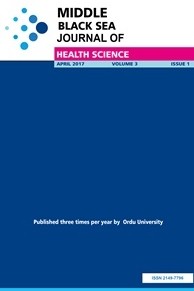Prognostic Value of Integrated Pulmonary Index (IPI) Value in Determining Pneumonia Severity in Patients Diagnosed with COVID-19 Pneumonia in the Emergency Department
Prognostic Value of Integrated Pulmonary Index (IPI) Value in Determining Pneumonia Severity in Patients Diagnosed with COVID-19 Pneumonia in the Emergency Department
___
- 1. Ronen M, Weissbrod R, Overdyk FJ, Ajizian S. Smart respiratory monitoring: clinical development and validation of the IPI™ (Integrated Pulmonary Index) algorithm. J Clin Monit Comput. 2017;31(2):435-442.
- 2. Pulia MS, O’Brien TP, Hou PC, Schuman A, Sambursky R. Multi-tiered screening and diagnosis strategy for COVID-19: a model for sustainable testing capacity in response to pandemic. Ann Med. 2020;52(5):207–14.
- 3. Jain S, Self WH, Wunderink RG, Fakhran S, Balk R, Bramley AM, et al. Community-acquired pneumonia requiring hospitalization among US adults. N Engl J Med. 2015;373(5):415-427.
- 4. Turkish Republic Ministry of Health, General Directorate of Public Health, COVID-19 adult patient treatment quideline. Accessed: Dec 6, 2021. [Online]. Available: https://covid19.saglik.gov.tr/Eklenti/40719/0/covid-19rehberieriskinhastayonetimivetedavipdf.pdf
- 5. Faul F, Erdfelder E, Buchner A, Lang AG. Statistical power analyses using G*Power 3.1: tests for correlation and regression analyses. Behav Res Methods. 2009;41(4):1149-60.
- 6. Ucan ES, Ozgen Alpaydin A, Ozuygur SS, Ercan S, Unal B, Sayiner AA, et al. Pneumonia severity indices predict prognosis in coronavirus disease-2019. Respir Med Res. 2021;79:100826. doi:10.1016/j.resmer.2021.100826
- 7. Artero A, Madrazo M, Fernández-Garcés M, Miguez AM, Garcia AG, Vieitez AC, et al. Severity Scores in COVID-19 Pneumonia: a Multicenter, Retrospective, Cohort Study. J Gen Intern Med. 2021;36(5):1338-1345.
- 8. Falcone M, Corrao S, Venditti M, Serra P, Licata G. Performance of PSI, CURB-65, and SCAP scores in predicting the outcome of patients with community-acquired and healthcare-associated pneumonia [published correction appears in Intern Emerg Med. 2013;8(6):549]. Intern Emerg Med. 2011;6(5):431-436.
- 9. Anurag A, Preetam M. Validation of PSI/PORT, CURB-65 and SCAP scoring system in COVID-19 pneumonia for prediction of disease severity and 14-day mortality. Clin Respir J. 2021;15(5):467-471.
- 10. Elmoheen A, Abdelhafez I, Salem W, Bahgat M, Elkandow A, Tarig A, et al. External Validation and Recalibration of the CURB-65 and PSI for Predicting 30-Day Mortality and Critical Care Intervention in Multiethnic Patients with COVID-19. Int J Infect Dis. 2021;111:108-116.
- 11. Holten AR, Nore KG, Tveiten CEVWK, Olasveengen TM, Tonby K. Predicting severe COVID-19 in the Emergency Department. Resusc Plus. 2020;4:100042.
- 12. Arnold FW, Ramirez JA, McDonald LC, Xia EL. Hospitalization for community-acquired pneumonia: the pneumonia severity index vs clinical judgment. Chest. 2003;124(1):121-124.
- 13. Lim WS, van der Eerden MM, Laing R, Boersma WG, Kralus N, Town GI, et al. Defining community acquired pneumonia severity on presentation to hospital: an international derivation and validation study. Thorax. 2003;58(5):377-382.
- 14. Aliberti S, Ramirez J, Cosentini R, Brambilla AM, Zanaboni AM, Rossetti V, et al. Low CURB-65 is of limited value in deciding discharge of patients with community-acquired pneumonia. Respir Med. 2011;105(11):1732-1738.
- Yayın Aralığı: Yılda 4 Sayı
- Başlangıç: 2015
- Yayıncı: Ordu Üniversitesi
Relationship of Thyroid Function with Metabolic Parameters in Euthyroid Adults
Evaluation of Sleep Quality of Anesthesiologists Working in Turkey
Zübeyir CEBECİ, Ebru CANAKCİ, Nilay TAŞ, İlker COŞKUN
Özgür KILIÇ, Mehmet POLAT, Kamil SANNAH, Melda DİLEK
May the Systemic Immune-Inflammation Index be an Indicator of Premature Ovarian Insufficiency?
Nurses' Covid-19 Vaccine Hesitancy: A Qualitative Study
Aslıhan ÇATIKER, Kamuran ÖZDİL, Gizem Deniz BULUCU BÜYÜKSOY, Gülhan KÜÇÜK ÖZTÜRK
Kronik Subdural Hematomda Burrhole Kraniostominin Etkinliği. Retrospektif 9 Yıllık Bir Çalışma
Yusuf KARAGÖZOĞLU, Tuğba Raika KIRAN
Morphometric Examination of The Tracheobronchial Tree in Cases with Foreign Body Aspiration
İnan KORKMAZ, Mehmet ÇELİKKAYA, Ahmet ATICI, Alperen KAYALI, Mehmet KARADAĞ, Fatma ÖZ
